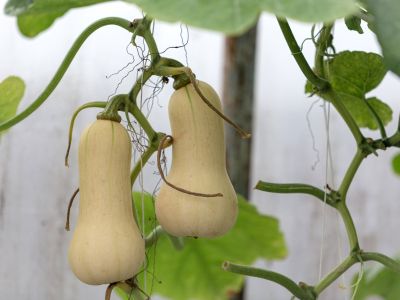Planting Butternut Squash
The butternut squash growing season begins when all danger of frost is past and the soil is well warmed by the sun, about 60 to 65 degrees F. (15-18 C.) at a 4-inch (10 cm.) depth. Butternut squash plants are extremely tender. The seedlings will freeze with the slightest frost, and seeds will only germinate in warm soil. Like most other vining vegetables, butternut squash cultivation begins with a hill. Draw your garden soil into a hill about 18 inches (46 cm.) high. This allows the soil to heat around the seeds and roots. Your soil should be well amended and well fertilized since butternut squash plants are heavy feeders. Plant five or six seeds per hill about 4 inches (10 cm.) apart and 1 inch (2.5 cm.) deep. Keep the soil moist, but not soggy. In about 10 days, the seeds will sprout. When they’re about 6 inches (15 cm.) high, thin out the weakest leaving three plants per hill. The butternut squash growing season is about 110-120 days for fruit maturation, so if your season is short, it’s best to start your seeds indoors to give them a head start. To grow butternut squash indoors, you’ll need to start about six weeks before the last frost in your area. Plant as you would most vegetables, in good soil in a sunny window or greenhouse and transplant to the garden after all danger of frost is past. Please remember to harden off the seedlings before transplanting.
Growing Butternut Squash
Butternut squash cultivation takes up a great deal of space in the home garden. Each hill should have at least fifty square feet for growing. Butternut squash seeds can send out vines up to 15 feet (4.5 m.) long. Fertilize well throughout the butternut squash growing season. Regular feeding will produce the most abundant crop as will keeping the hills weed free. Butternut squash cultivation should be done by hand or with a hoe. Don’t cultivate too deeply since the roots are shallow. Watch carefully for bugs and when the need arises, use insecticidal soap or apply insecticides in the evening when the bees have returned to the hive since bees are essential to growing butternut squash successfully. Your squash will be ready for harvesting when the skin turns hard and is difficult to pierce with your thumbnail. Butternut squash can be roasted or boiled and makes a particularly tasty substitute for pumpkin in pie. Once you know how to grow butternut squash, the possibilities are endless, and your neighbors and friends will appreciate sharing your bounty.
